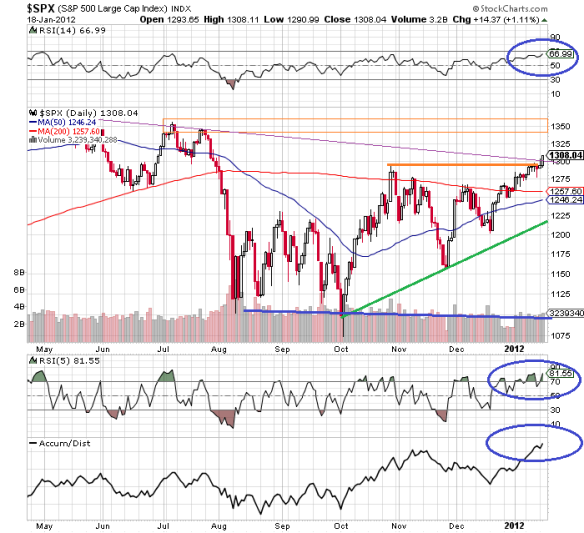First of all my apologies. Between the holiday season and the start of a couple of new projects, I have neglected to post our market commentary here in a month! Since we want this to be at least weekly, my daughter would say “fail!” So with no further delay…
Let’s look at the market environment. As a reminder, our reference to the “market” refers to the stock market represented by the S&P 500 Index. There is an old adage that if you cannot tell who the fool is at the table, when gambling, you are probably it. For many investors, we guess they are starting or already feel this way. After a decade of going nowhere when it comes to capital gains, getting scared to death this last summer, many are now feeling the market is heading up without them. Looking at a variety of measurements and a few fundamentals will guides. Up front, we have been underweight equities for several months. Our patience is wearing thin as well. However, we need to see better prices before adding to equity positions. Using the chart below, which is click-able to expand, we can see some of the risks that are not readily apparent.
Price alone, we would think that all is well with the world and the economic recovery is accelerating to a new cycle of growth and higher employment! So if you rode this train, fully invested, good for you! (Sarcastically I would say the same people also enjoyed the ride down from the end of July, not getting back to even.) On the positive side, the S&P 500 Index has pushed up through a lot of resistance. The 50 day moving average (blue curve), 200 day moving average (red curve), and the down trend of peak prices (magenta line moving down from left to right) have offered only a few setbacks to the price advance. Now the next resistance point is all the way back up at the 1350 area, which is where we were before the August slide. From a news perspective, the U.S. has not fallen back into a recession, Europe did not “meltdown,” and earnings seem to be doing well.
Now the other side of the coin. The rally since early October has been accompanied by steadily declining volume (blue line). This is not healthy. One of the reasons there is slowing volume is that the selling is declining, which is different from buying increasing. How do we know. NYSE short interest, you know the people who sell stocks they do not have, has steady declined to a multi-month low, to the low-end of normal ranges. So the selling pressure has lifted, not new buying. Additionally three other indicators are signaling a topping point (blue circles). First the longer term Relative Strength Index (RSI) at the top of the chart is nearing a topping point. It can go higher, but as long as we are near or above the over-bought area toward the top of the indicator, the odds decrease that the move can be sustained. The medium term RSI, near the bottom of the chart, is also at a sustained oversold condition. A condition that we have not seen since December 2010 through mid February 2011. That run helped push us to the market high of 2011. So we are at or near an oversold peak, but yet have not recovered fully in price to May 2011 levels.
Not to pile on, but we need to point out the 200 day moving average (red curve), has not yet turned up, and the Accumulation/Distribution line (bottom of chart) is at a 3 year peak! Again, without a corresponding peak in prices. Fundamentally, signs are showing up that the economy is not accelerating. There are mixed signals for growth and contraction. Europe is not fixed. If Europe does not enter a banking/liquidity/credit crisis, then at the very least, the increased European Central Bank borrowing and liquidity injections will only prove to be a drag on future growth. (Yes borrowing and printing money only takes away from growth in the future. But since it is too difficult to quantify, the temptation to try to stimulate now is to great for most governments and central banks to overcome.) Additionally there is political uncertainty in the U.S. surrounding the sustainability of borrowing $1 TRILLION or more of new debt annually.
All that said, it is hard to put new money in the market at this point. To launch as sustained multi-quarter bull market, we need a healthy pull back. Even a correction back to the 200 day moving average (red curve) would be a start. We would look at that opportunity to increase stock market exposure. Our favorites would still be dividend paying equities or dividend heavy ETFs (Exchange Traded Funds), with an overweight position in energy.
As always, if you have any questions, or would like to speak with us, please contact me by email. scott.noble(at)terniongroup.com
















